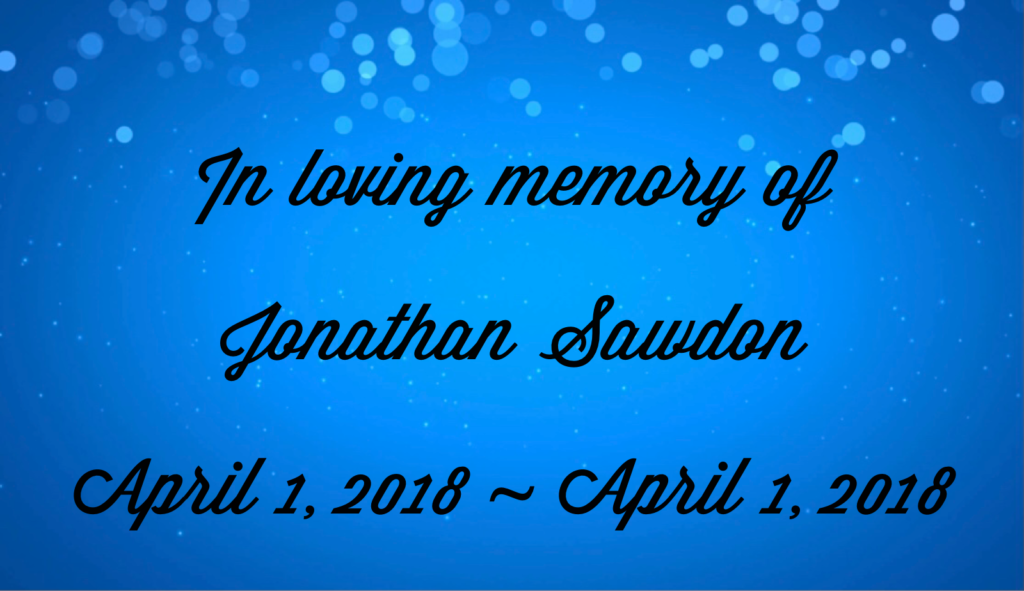Uncategorized
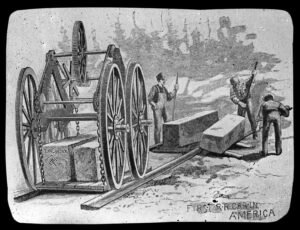 As with any new form of transportation, the first accident is inevitable. There may have been train wrecks in other countries, but the first recorded railroad accident in United States history happened on July 25, 1832, when four people were thrown off a vacant car on the Granite Railway near Quincy, Massachusetts. The people were there by invitation, to watch the process of transporting large and weighty loads of stone. The victims were observing From a vacant car as the large were being loaded. Suddenly, a cable on the vacant car snapped, throwing them off the train and over a 34-foot cliff, one man was killed and the others were seriously injured. It was a fluke, and no one could possibly have known of expected such a break. I suppose that cables had not been used for the purposes they now were…loading large rocks and their duties on trains. Cables can fray and snap. That is just a fact of life. Death is a fact of life, and on that day, when the cable broke, the wagon containing Thomas B Achuas of Cuba was killed when the wagon derailed as he and three other tourists were taking a tour.
As with any new form of transportation, the first accident is inevitable. There may have been train wrecks in other countries, but the first recorded railroad accident in United States history happened on July 25, 1832, when four people were thrown off a vacant car on the Granite Railway near Quincy, Massachusetts. The people were there by invitation, to watch the process of transporting large and weighty loads of stone. The victims were observing From a vacant car as the large were being loaded. Suddenly, a cable on the vacant car snapped, throwing them off the train and over a 34-foot cliff, one man was killed and the others were seriously injured. It was a fluke, and no one could possibly have known of expected such a break. I suppose that cables had not been used for the purposes they now were…loading large rocks and their duties on trains. Cables can fray and snap. That is just a fact of life. Death is a fact of life, and on that day, when the cable broke, the wagon containing Thomas B Achuas of Cuba was killed when the wagon derailed as he and three other tourists were taking a tour.
While it was a setback, trains were, in fact, a matter of necessity, and the acceptance of railroads came quickly in the 1830s and beyond. By 1840 the United States had almost 3,000 miles of railway, which was more than the combined European total of only 1,800 miles. The railroad network expanded quickly in the years before the Civil War, and by 1860 the American railroad system had become a national network of some 30,000 miles. 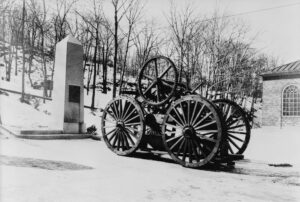 Nine years later, transcontinental railroad service became possible for the first time. These were great successes, but they did not come without a price, and sometimes that price is very heavy.
Nine years later, transcontinental railroad service became possible for the first time. These were great successes, but they did not come without a price, and sometimes that price is very heavy.
When architect Solomon Willard arrived in Quincy, Massachusetts, in 1825, and discovered a granite ledge in a wooded area, he knew he had found the perfect raw material for what would become his most famous building, the Bunker Hill Monument. Willard envisioned a 221-foot tall monument with a 30 feet square base that would require some 6,700 tons of granite. Transporting the massive blocks of granite from the quarry to the site of construction presented a challenge. That’s where the train came in. Quincy was separated from Charlestown, where the monument would be erected, by 12 miles of swamp, forest, and farms. The granite needed to be delivered to Neponset River, four miles north, from where a barge would transport the stone through Boston Harbor to Charlestown. Willard wanted to move the stones to the Neponset River on sledges during winter, but engineer Gridley Bryant, suggested a more efficient method…a railroad.
With the support Boston businessman and state legislator Thomas Handasyd Perkins, Bryant ended up designing what would become the first, commercial railroad in the United states. Rather than steam locomotives, Bryant used horses to pull the railcars a distance of three miles from quarries to the Neponset 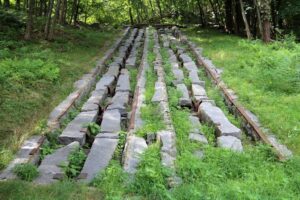 River. A single horse could pull three cars loaded with 16 tons of rock over wooden rails plated with iron. Later, the wooden rails were replaced with granite rails. The iron plates were retained.
River. A single horse could pull three cars loaded with 16 tons of rock over wooden rails plated with iron. Later, the wooden rails were replaced with granite rails. The iron plates were retained.
Although, Bryant benefitted from developments already in use on railroads in England, he did modify his design to allow for heavier, more concentrated loads and a three-foot frost line. The Granite Railway also introduced several important inventions, including railway switches or frogs, the turntable, and double-truck railroad cars. Gridley Bryant never patented his inventions, believing they should be for the benefit of all.

 My Aunt Dixie Richards, the 8th child of my grandparents, George and Hattie Byer. Grandma and Grandpa kind of had three families…or so it seemed to all of us anyway. The first three were girls, Evelyn, Virginia, and Deloris. The second three were two boys, Larry and Wayne, with my mom, Collene in the middle. The last three were three girls, Bonnie, Dixie, and Sandy. By the time Aunt Dixie was five years old, she was an aunt. Her sister, Evelyn had married and given birth to a daughter named Sheila “Susie” (Hushman) Young. I’m sure it seemed strange to be a child of five, and have a sister who was married and a mother…but then, I was the second oldest child, so that situation couldn’t have happened with me. My youngest sister, Allyn (Spencer) Hadlock was an aunt when she was eight years old, so I’m sure she could relate to how Aunt Dixie felt at that time…both as a young aunt, or later as a teenaged aunt.
My Aunt Dixie Richards, the 8th child of my grandparents, George and Hattie Byer. Grandma and Grandpa kind of had three families…or so it seemed to all of us anyway. The first three were girls, Evelyn, Virginia, and Deloris. The second three were two boys, Larry and Wayne, with my mom, Collene in the middle. The last three were three girls, Bonnie, Dixie, and Sandy. By the time Aunt Dixie was five years old, she was an aunt. Her sister, Evelyn had married and given birth to a daughter named Sheila “Susie” (Hushman) Young. I’m sure it seemed strange to be a child of five, and have a sister who was married and a mother…but then, I was the second oldest child, so that situation couldn’t have happened with me. My youngest sister, Allyn (Spencer) Hadlock was an aunt when she was eight years old, so I’m sure she could relate to how Aunt Dixie felt at that time…both as a young aunt, or later as a teenaged aunt.


Being an aunt when you are just a kid yourself, means that you are a fun aunt. When the nieces and nephews are over, you get to take them outside or to your room to play. Of course, as the aunt gets older, those little ones might not be so much fun to have around. Teenagers aren’t always fond of little tag-a-longs. Of course, they forget that for their older siblings, these teenaged aunts were the tag-a-longs once. I’m sure that the older kids didn’t always want to have the responsibility of taking care of the little ones.
I think that Aunt Dixie must have liked taking care of the little ones though, because in later life she even ran a 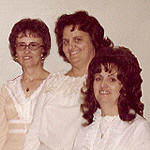
 daycare, and took care of many of the children in the family…as well as her own grandchildren, Jacob Liegman, Charles Williams, Gideon Williams, Noah Williams, and Mayme Williams. Taking care of her own grandchildren was a highlight of her life. She still sees them every day, and they love spending time with her and their grandpa, Jim Richards. The blessings of having children are the continuing line…the grandchildren. Today is Aunt Dixie’s 77th birthday. Happy birthday Aunt Dixie!! Have a great day!! We love you!!
daycare, and took care of many of the children in the family…as well as her own grandchildren, Jacob Liegman, Charles Williams, Gideon Williams, Noah Williams, and Mayme Williams. Taking care of her own grandchildren was a highlight of her life. She still sees them every day, and they love spending time with her and their grandpa, Jim Richards. The blessings of having children are the continuing line…the grandchildren. Today is Aunt Dixie’s 77th birthday. Happy birthday Aunt Dixie!! Have a great day!! We love you!!
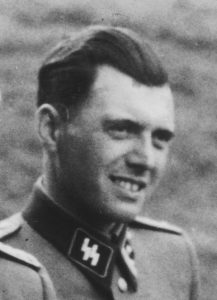
 Rolf Mengele was born in March 16, 1944 in Freiburg, Germany to Irene Schoenbein and Dr Joseph Mengele…also known as the Angel of Death, but his father went into hiding after the war, and escaped to Argentina in 1949. Because of this, Rolf grew up in a loving home with his grandparents and his mother. He didn’t meet his father until he was a teenager, because he was told that he was dead.
Rolf Mengele was born in March 16, 1944 in Freiburg, Germany to Irene Schoenbein and Dr Joseph Mengele…also known as the Angel of Death, but his father went into hiding after the war, and escaped to Argentina in 1949. Because of this, Rolf grew up in a loving home with his grandparents and his mother. He didn’t meet his father until he was a teenager, because he was told that he was dead.
When he turned 16, Rolf learned that his father was actually alive when Joseph made contact with him. It was an unhappy revelation for him. His father made attempts to bond with him through letters, even writing and illustrating a children’s book for him, but to no avail. His father’s attempts didn’t stop the feelings of disgust he felt about his father’s beliefs and actions. Still, at 16, he felt a curiosity about his dad, and wanted to meet him. Since Joseph Mengele was still wanted by Nazi-Hunters, for his war crimes, it took Rolf 5 years to arrange a trip to Brazil to visit his father.
Rolf had to travel under a stolen passport, but he wanted to go, because he wanted to understand how his father could have been an active participant in the Nazi death machine. He didn’t wait long, after his arrival, to bring up the subject of Auschwitz. His dad immediately became defensive, denying any responsibility for the atrocities, but actually admitting to participating in the nightmare “experiments” that the Jewish people were subjected to. He acted like he was doing them a favor, saying, “What was I supposed to do with those people? They were sick and half-dead when thy arrived.” He tried to tell his son that all he was doing was to determine who was fit to work. He actually claimed to have saved several thousand people by allowing them to work.
After his visit, Rolf found it “impossible to betray his father’ location,” but his feelings of disgust remained with him for the rest of his father’s life. Rolf says, “I didn’t even bother to listen to him or think of his ideas. I simply rejected everything he presented. I will never understand how human beings 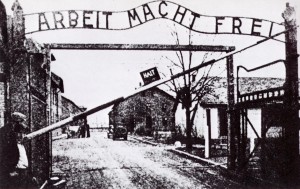 could do those things. That my father was one of them doesn’t change my opinion.”
could do those things. That my father was one of them doesn’t change my opinion.”
Joseph Mengele’s health began to deteriorate in 1972. In 1976 he suffered a stroke. Then on February 7, 1979, he had another stroke while swimming in the Atlantic Ocean off of Bertioga, Brazil during a visit with friends. He drown and was buried under the alias of Wolfgang Gerhard, which he had been using since 1971. Rolf abandoned the Mengele name in 1980, taking his wife’s last name to spare his children the burden of their grandfather’s past. Rolf and his family live in Freiburg, Germany, where he is an attorney.
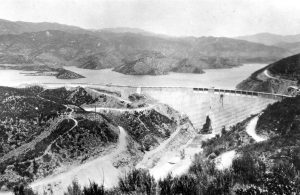 When the Civil Engineers build a dam, it is a structure that is expected to last for many years to come. The build dams for recreational purposes, as well as economic purposes. In August of 1924, civil engineers began construction of the Saint Francis Dam. The dam was to be a curved gravity dam located near Los Angeles in the San Francisquito Canyon, close to Santa Clarita. Chief Engineer William Mulholland supervised the project as a part of the Los Angeles aqueduct system.
When the Civil Engineers build a dam, it is a structure that is expected to last for many years to come. The build dams for recreational purposes, as well as economic purposes. In August of 1924, civil engineers began construction of the Saint Francis Dam. The dam was to be a curved gravity dam located near Los Angeles in the San Francisquito Canyon, close to Santa Clarita. Chief Engineer William Mulholland supervised the project as a part of the Los Angeles aqueduct system.
The construction of the dam was completed on May 6th, 1926. While the dam was very new, it still began to exhibit signs instability and leaks shortly after the work was completed. Apparently, there were a few flaws in the construction of this dam. The problems with the Saint Francis Dam continued until on March 12, 1928 at 11:57pm, the dam suffered a catastrophic failure causing a massive flood with little to no warning for residents 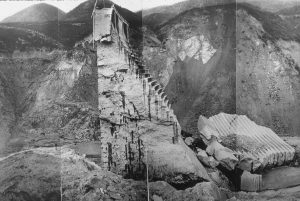 in the surrounding area. Many thought that the rumbling from the dam may have been an earthquake, only to find out very quickly that the dam had failed in a catastrophic way. Without warning, the flood water came rushing down the river and into the unsuspecting town.
in the surrounding area. Many thought that the rumbling from the dam may have been an earthquake, only to find out very quickly that the dam had failed in a catastrophic way. Without warning, the flood water came rushing down the river and into the unsuspecting town.
The resulting flood left between 385 – 430 people dead according to some of the official estimates. In reality, the number may have been higher…possibly over 600 dead. The carnage caused the collapse to be considered one of the worst civil engineering failures in United States history. The flood waters…12 billion gallons strong were initially 140 feet high. Several Southern California towns suffered massive damage due to the collapse including Castaic, Saugus, Santa Paula, Saticoy, and Filmore. It was estimated that 1,200 homes were d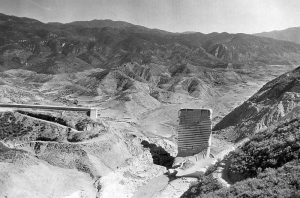 estroyed with damages in the $7 million range.
estroyed with damages in the $7 million range.
Investigations into the collapse found that issues with the dam’s foundation were at fault. It was also later reported that the dam may have been built on the site of an old landslide that could have contributed to the foundation issues. The collapse ended Mulholland’s career, because many people blamed him for the catastrophe, partially because he and his assistant had personally inspected the dam just 12 hours before the failure and had deemed it safe. It was determined that the dam would not be rebuilt, and what was left of the Saint Francis Dam was demolished in May of 1929.

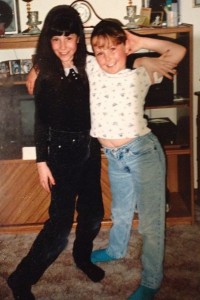 Throughout their childhood, my nieces, Michelle Stevens and Lindsay Moore were the best of friends. They were always having adventures…usually funny ones. The girls at one time decided that they needed a secret language, so that they could communicate all their little girl secrets privately. Of course, in reality they were talking gibberish, but the language sounded close enough to legitimate, that it might have fooled the untrained ear. The girls loved to talk their secret language…especially in public. They actually got pretty good at it, and might have even understood each other, as can happen in these developed childhood languages.
Throughout their childhood, my nieces, Michelle Stevens and Lindsay Moore were the best of friends. They were always having adventures…usually funny ones. The girls at one time decided that they needed a secret language, so that they could communicate all their little girl secrets privately. Of course, in reality they were talking gibberish, but the language sounded close enough to legitimate, that it might have fooled the untrained ear. The girls loved to talk their secret language…especially in public. They actually got pretty good at it, and might have even understood each other, as can happen in these developed childhood languages.
Michelle’s imagination was quite good. She likes to tease people in pure “Michelle” fashion, by telling people she was on her way to their house, when she was actually at home. She even went so far as to say she was outside their house, and could see them through their window…when in reality, she never really intended to come over at all. She was quite funny, and I think maybe her imagination soon led to her chosen career…art.
After Michelle graduated from Black Hills State University, with a teaching degree and an art degree, she moved back to Casper, Wyoming, hoping to get a job in the local school district. With the country in a downturn, schools were closing, and jobs weren’t available. So, Michelle found another type of dream job. The Nicolaysen Art Museum snatched her right up for a teaching position there. Michelle loves working with the various groups, teaching art projects and classes with people of all ages. Veterans, home schoolers, art club, seniors. This is a different kind of teaching than she thought she would be doing, in that the students are of all ages. That is an unexpected pleasure for Michelle, who didn’t expect to be working with adults, when she went into teaching. She absolutely loves it.
For an artist, the art museum is a favorite place to be, and she love the Nicolaysen, and takes great pride in it, as well as working there. Recently, Michelle was chosen to do an Art Integration Conference for teachers Professional Development. It was a great honor. She was a presenter for one of the sessions, at which time gave a lecture about Art Basics for the Non-Artistic. Hmmm…I should have attended that one, since Michelle has more artistic ability in one strand of hair, that I have in my whole body. Her lecture was a quick breakdown of Introduction to Art, after which she gave the teachers various strategies on ways to integrate art into any class. The people at the museum are super impressed with her and have put their faith in her. Her boss, Zhanna wants her to help her develop a whole Art integration Conference for 2021. We are very proud of her.
Time changes things, and for Michelle, that means that with the improving economy, the Natrona County School District is once again looking at her for teaching positions. She will start substitute teaching in the 
 school district in January, and she is hoping to land one of the three art teacher positions opening in the school in June. Of course, that would mean leaving the Nicolaysen…a move that saddens both Michelle and her work family at the Nicolaysen. She has not finalized her plans in that respect, but it is an opportunity that will be impossible to pass up. We all wish her well, in whatever decision she makes. Today is Michelle’s birthday. Happy birthday Michelle!! Have a great day!! We love you!!
school district in January, and she is hoping to land one of the three art teacher positions opening in the school in June. Of course, that would mean leaving the Nicolaysen…a move that saddens both Michelle and her work family at the Nicolaysen. She has not finalized her plans in that respect, but it is an opportunity that will be impossible to pass up. We all wish her well, in whatever decision she makes. Today is Michelle’s birthday. Happy birthday Michelle!! Have a great day!! We love you!!



